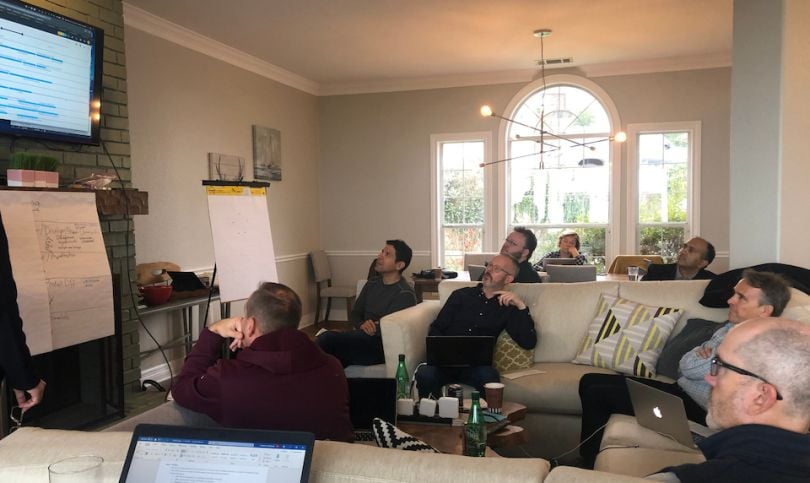Doesn’t every sales team want to sell more?
An effective sales enablement strategy can increase productivity and sales results. Companies with sales enablement have 15 percent better win rates than those that lack it, according to a recent report from CSO Insights.
“Sales enablement is vital to maximizing attainment, but a lack of coordination too often leads to time wasted in poorly planned or executed enablement sessions,” Liquibase CEO Derek Hutson said.
Hutson, who has led the software company for five years, stressed the importance of synchronization between teams when developing sales enablement strategies. There can be numerous cross-departmental stakeholders involved in creating even one enablement initiative, like developing new product documentation. But if various teams aren’t on the same page surrounding goals or updated processes, it can lead to wasted time and effort.
GoDaddy Senior Sales Manager Max Yanke agreed, and said to avoid misalignment in creating enablement strategies, all the involved stakeholders should meet at least once a week. Eric Paul, senior Salesforce administrator at LumApps, added that typically, senior leaders dictate the direction enablement should head in, while sales leaders coordinate to see those goals through.

What’s just as important as leaders collaborating to develop enablement strategies? Ensuring that salespeople interact effectively with customers to, well, sell. For GoDaddy Senior Sales Manager Max Yanke, that means frequently providing his team with the training they need to understand customers as deeply as possible. Reps are given instruction on topics like industry verticals and pipeline management.
Who are the key stakeholders you need to create alignment with when developing a successful sales enablement strategy?
There are a significant number of stakeholders involved in creating our sales enablement strategy: trainers, sales managers and reps, the customer success team, senior leaders and account managers. Sales leaders also work hand-in-hand with the data operations team to set goals, identify areas of opportunity and ensure there is a clear action plan to drive results. This teamwork allows us to have a high level of accountability with our leaders and the sales floor.
Creating alignment across these departments requires constant collaboration and communication regarding our sales process to uncover any gaps. So we’re meeting at least weekly. We take a lot of pride in our alignment with goals and expectations, which allows us to move quickly on any needed changes. The communication between our teams has allowed us to not only scale quickly and effectively over the last year, but has also positioned us for future growth in our sales department.
There are typically at least two lunch-and-learns per department each week.”
What sales enablement tools are most important in helping your salespeople succeed?
We preach that “learners are earners.” So on top of our new-hire training, there are typically at least two lunch-and-learns per department each week on topics like industry expertise training, pitch theory, pipeline management and the customer-buying cycle. Our training sessions are centered around being able to communicate more effectively with customers so that we can understand their needs and goals. GoDaddy sales reps work with a wide range of industries, so varied training and coaching enables their adaptability.

At LumApps, getting an effective sales enablement strategy in place takes collaboration. Senior Salesforce Administrator Eric Paul said various stakeholders at the company bring their vision for the sales department to the sales operations team, which digests their requests before reaching out to sales leaders for their input.
Who are the key stakeholders you need to create alignment with when developing a successful sales enablement strategy?
Stakeholders tend to start with high-level leadership and a vision they have for the sales department. They will bring that vision to us on the sales operations team, and we will do our best to digest their requests then reach out to sales leaders to get their input. We try to facilitate the process by talking with the sales department leaders, vetting what their hopes are for our strategy and lining those up with the high-level leadership vision. Then, we put a plan in place to deliver the technical aspects that we need to make the goal a reality.
We are always reviewing and improving our use of Salesforce.”
What sales enablement tools are most important in helping your salespeople succeed?
We are heavy Salesforce users, but we have additional tools we use in conjunction with that such as Salesloft and Pardot. We are always reviewing and improving our use of Salesforce and the processes we have in place that help our sales, marketing and management teams. Those processes include automation tools to create opportunities, keep data up to date and keep our customers informed.

Goal-alignment between key stakeholders is a vital part of creating enablement resources for sales teams, but that’s easier said than done. Liquibase CEO Derek Hutson said sometimes marketing, product management and sales leadership have competing priorities, which makes communication and coordination crucial. It’s also important not to forget to receive input from the very team these initiatives are being made for: individual salespeople.
Who are the key stakeholders you need to create alignment with when developing a successful sales enablement strategy?
Key stakeholders include marketing, product management and obviously sales leadership. Everyone feels they need to “enable” sales to do something, and a challenge is that oftentimes these teams have competing priorities. But don’t overlook the individual salespeople as stakeholders. Listen to them and often, they will tell you what is needed.
Guided by business objectives, sales leadership needs to own coordinating with all the stakeholders, setting priorities, schedules and content guidelines. Sales enablement is vital to maximizing attainment, but a lack of coordination too often leads to time wasted in poorly planned or executed enablement sessions.
It’s important to ensure there are clear and measurable action items after the enablement.”
What sales enablement tools are most important in helping your salespeople succeed?
It’s important to ensure there are clear and measurable action items after the enablement. Know and communicate what is expected from the team post-enablement.
Secondly, the sales team needs to be involved in their own enablement. They can be great at coaching one another and this helps create mastery and ownership of the subject matter.






